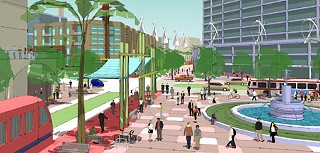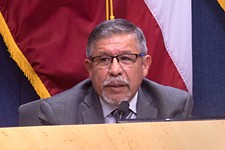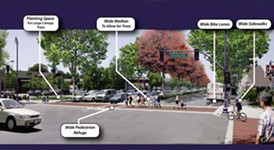Developing Stories: The Promise of Planning
Can the city deliver on East Riverside?
By Katherine Gregor, Fri., Feb. 12, 2010

"I truly believe this can be the next 'SoCo' – even the history of S. Congress was an area with a lot of crime, drugs, prostitution, etc. – now look at it."
"Let's do this! Currently it is a real eyesore."
"What can we do to make this happen?"
Austinites shared the comments above – on an ambitious city master plan for transforming East Riverside Drive – nearly a year and a half ago, at community visioning workshops. The planning effort, led by A. Nelessen Associates Inc., drew enthusiastic public response. Hundreds of people attended the four-hour workshops and other meetings (contributing over 1,600 volunteer hours), submitted nearly 600 surveys (English and Spanish), and shared their insights. The city spent more than $180,000 on the consultant and invested countless staff hours. Today (Feb. 11) the plan documenting that massive act of faith finally comes back to City Council for a 10:30am public briefing by Anton Nelessen. On Feb. 25, council may act to adopt the East Riverside Corridor Master Plan. But once adopted, how does it become real?
"The draft master plan hinges on the premise that rail transit will run down Riverside Drive, between I-35 and Ben White, and on out to the airport," we reported last July ("New Urbanism Comes to East Riverside," July 3, 2009). "Leveraging the transformational powers of transit-oriented development, the corridor plan shows East Riverside losing its car focus (e.g., a blur of parking lots and strip shopping centers) in favor of a people focus (attractive places to walk, recreate, eat, shop, and live)." The plan's vision statement describes a reborn corridor steeped in New Urbanist virtues – compact, human-scaled, pedestrian-friendly, and bikeable, with mixed-use town centers around transit stations, generous open space, and a green network – to help boost regional sustainability and reduce travel by car.
In leading the community down this rosy planning path, the city made an implicit promise. Now it needs to show it can deliver. As in the current comprehensive plan process (see "Imagining Austin," Jan. 29), the East Riverside planners asked Austinites to rally around solutions of citywide and regional importance. As in the new corridor initiative for Airport Boulevard (see "Reinventing Airport Boulevard," Jan. 8), they seek to harness rail transit as an economic and placemaking engine for an area's rebirth. To build citizen trust and confidence in the comprehensive plan, it is incumbent upon the city to prove that planning matters by turning vision into reality on Riverside.
A Better Future
But how do we know Austinites want to see East Riverside Drive change? Erica Leak, the city's lead planner on the East Riverside Corridor Master Plan, cited a thick stack of survey forms, filled out by about 140 people who attended two community visioning workshops in August and September 2008. (About 160 people also attended the November 2008 public meeting, which presented concept plans and asked "Did We Get It Right?") She pointed as well to the results of a Visual Preference Survey, which about 450 people took online. Overwhelmingly, they gave thumbs-down to photos of East Riverside now and thumbs-up to images of vibrant "people places" with wide sidewalks, trees, and shops and cafes that meet the street. In addition, 77% supported the idea of infill redevelopment in mixed-use "nodes" around transit stops.
Reading people's handwritten survey comments proved surprisingly moving – they reflect a pent-up yearning for a much safer, nicer place. At the same time, current low-income residents in Montopolis and along East Riverside worry that improvements – however well-meaning – would price them out. "I understand growth is inevitable and vital," as one put it. "We are planning for a better future – unfortunately it will become a wonderful place where I will no longer afford to live." Other workshop participants said the transformation couldn't come fast enough. "Just make it clean and safe, soon"; "Let's get on the list, Now!!"; "It needs to happen – and soon"; "Get it going!"; "Looks great! How many years until this will be effectively underway?"
Three years have dragged by since the originating council resolution, so the city needs to show brisk progress. "A catalyst project can demonstrate commitment to realizing the plan; it provides a tangible example of the vision and encourages similar efforts on the part of other public and private entities," states the master plan's Section 8: Implementation. At the top of the list is rail transit, which still could be a decade away. (The Transportation Department is doing its own separate corridor study for East Riverside.) Also prioritized, to seed a first "node," is a Pleasant Valley Transit Plaza; for now, it could offer enhanced bus and bus rapid transit service. (Doug Allen at Capital Metro said bus rapid transit on East Riverside potentially could receive needed federal funding within a couple of years.)
Get Real
The plan highlights city-owned land at the intersection of Riverside and Pleasant Valley as an ideal site for a public plaza. Even lower-hanging fruit: improved pedestrian crossings, a network of bicycle lanes, completion of Country Club Creek Trail, and stepped-up crime reduction. Those relatively affordable projects should "get on the list, now" for the city's Strategic Mobility Plan, the November transportation bond package, and city department 2010-2011 budgets. If Austinites see that happen, they might actually start to believe that grand urban plans make a difference.
But other key recommendations need a bracing slap of reality. The plan calls for new "design-based" zoning for the corridor, to be written by city staff; what it really needs is a form-based code professionally written to hard real-estate market data. (The master plan lacks any economic analysis or direction on value-capture – a glaring omission.) It also calls for creating a density-bonus system, in which developers would earn additional height around transit stops (beyond the 60 feet already allowed) by funding parks and affordable housing and even transit facilities. But as a primary funding mechanism, that's a pipe dream. Survey respondents were quite cool to high-rise construction on East Riverside, and they're right – midrise construction is more compatible, provides plenty of added density, and yields far more affordable homes. (A separate issue is whether rail transit needs more density to be economically feasible.) The Downtown Austin Plan's economic analysis of density bonuses has shown (though no one wants to believe it) that commercial density bonuses simply don't make economic sense on Congress Avenue – so they sure won't attract high-rise hotels or office towers to East Riverside.
The city needs to get real, instead, about a solid financing plan for public improvements – e.g., a value-capture mechanism, such as tax-increment financing – to attract private investment. As one workshop participant put it: "I hate to be negative, but some ideas seem very 'pie in the sky,' and this area needs realistic solutions that can be funded and implemented."
For more information, visit www.cityofaustin.org/urbandesign/riversideplan.htm.
Got something to say on the subject? Send a letter to the editor.










